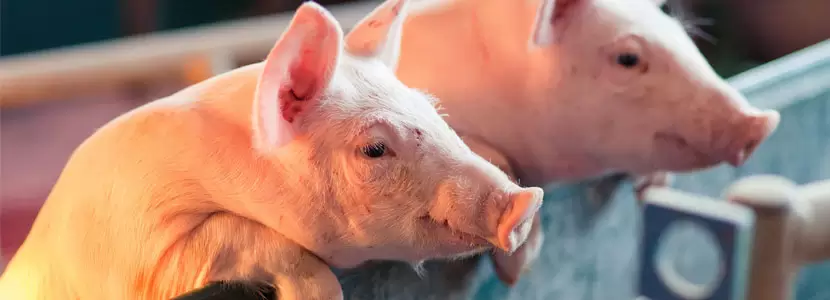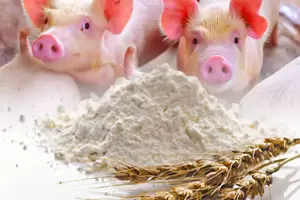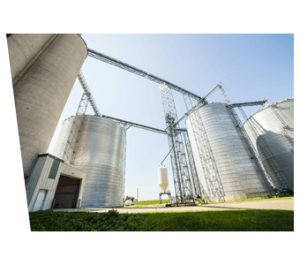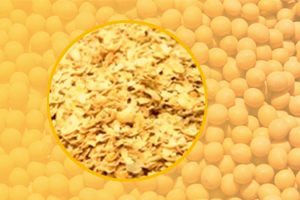 14 Sep 2022
14 Sep 2022
Raw materials for pig feed manufacturing
The main ingredients(raw materials) that make up the diets for pigs are corn as the majority energy source, the by-products of the extraction of soybean oil (flour, expeller and pellets) as a protein source and vegetable oils (soybean oil) as energy concentrates in diets that require it.
Energy Raw materials
Corn is the most accessible grain in Argentina, although due to different circumstances of price, geographical region and availability, sorghum, wheat, oats and barley are also used in various formulations.
These cereals are important ingredients, since they occupy a high percentage of inclusion within pig diets; the main characteristic is its high energy value, provided mainly by starch and fat, presenting differences regarding its composition between the different crops.

Some of them have limitations in their use due to the lack or low presence of digestive enzymes in animals that hinder the breaking of chemical bonds so that nutrients are released, being advisable the use of exogenous enzymes (β-glucanases, xylanases, proteases, phytases) for a better use of them.
Corn is characterized by its high energy value, good palatability and low presence of anti-nutritional factors; the level of inclusion within diets (50 to 70%) significantly influences the quality of it, providing 63% of metabolizable energy and 25% of protein in fattening diets.
Rostagno points out that damaged grains have worse nutritional value compared to normal grain due to changes in their chemical composition, with reduced bioavailability of some nutrients, presence of anti-nutritional factors and the proliferation of fungi with or without mycotoxin production.
Therefore, analyzing the type of grain we use in our formulations is important, since broken grains have 90 Kcal of Metabolizable Energy / Kg less than whole grains (Dale, 1994),
It is also important to evaluate the storage conditions (temperature, humidity, actions of fungi, insects) since if these are inadequate, they can reduce from 5 to 25% the metabolizable energy of corn (Krabbe, 1995).

Fats of animal origin and derived from oilseeds are widely used in animal nutrition. Soybeans and sunflowers are the most important oilseed crops in our country, the first being the one with the highest growth and volume, placing Argentina among the main exporters worldwide.
The industry accompanied this growth, so soybean oil is an input available in pig-producing areas. The oil is obtained from the pressing and or solvent extraction (Hexane) of the soybean bean.
The oil obtained contains 99.6% fat and a significant amount of linoleic acid (52.57%) (Rostagno, 2011).
The inclusion in the diets of both fattening and breeding, allows to achieve desirable energy levels in particular situations, such as:

It is important to control the quality of the oil to be used, since any alteration influences and harms the performance of the animals.
Controlling acidity (acidity index) determines the content of free fatty acids, being a measure of oil deterioration; and the peroxide index, which measures the oxidative rancidity of the oil, which involves chemical transformations that change organoleptic characteristics.
[register] Protein Raw Materials
The protein sources of choice in Argentina are the solid by-products derived from the industrial extraction of oil to the soybean bean, through mechanical, thermal and chemical solvent processes, from which expellers, extraction flours and pellets are obtained.
The processes by which soybean oil is extracted are by pressure (press and / or extruded) where the resulting solid by-product is the soybean expeller, and extraction based on the application of solvents (Hexane) where soybean meal is obtained as a solid by-product.

Pellets are compressed in the form of a cylinder that can come from any of the above, also from combination of processes (Pressure-Solvent).
These by-products are a high source of protein, providing essential amino acids necessary for pig diets. Its quality is variable depending on the production processes and the quality of the soybean bean (raw material).
The levels of inclusion in diets for fattening pigs vary between 20% to 37%, providing between 40% to 70% of the crude protein and 20% to 28% of the metabolizable energy of the diet.
Soy derivatives are highly palatable ingredients, however if they are not processed correctly they present inconveniences due to their content of oligosaccharides that are not digested, antitrypsin factors and allergenic factors (glycine and β-conglycine), present in the soybean bean.
Soy contains a high concentration of carbohydrates consisting of non-starchy polysaccharides (PNAs) and free sugars (oligosaccharides), these being one of the main factors responsible for the antinutritional effect of soybeans (M. Choct et al., 2010).
Pigs do not have endogenous enzymes capable of digesting certain oligosaccharides, the fermentation of these can cause flatulence and diarrhea (Zhang et al., 2003).
The industry has developed thermal and biotechnological processes capable of reducing or eliminating these anti-nutritional factors, achieving good quality by-products with a high contribution of amino acids.

It is advisable to stipulate a routine sampling for laboratory control of the quality of these soybean meals, to ensure that the amino acid profile has not been damaged, allowing to achieve the expected performances on the farm.
Author: MV, Esp. in Animal Nutrition, Marcelo Pooli
Bibliographic References
LIMA by M. Gustavo J.M., Souza de, Osny Waltrick. IMPORTANCE OF GRAIN QUALITY IN PIG PRODUCTION. Embrapa Pigs and Birds. [email protected]
José María Mendez et al. Processing of soybeans in the province of Santa Fe by extruding and pressing. INTA EEA OLIVEROS 2010
Débora Cristine de Oliveira Carvalho y col. Chemical and Energetic Composition of Corn Samples Submitted to Different Drying Temperatures and Storage Periods. R. Bras. Zootec., v.33, n.2, p.358-364, 2004
Rostagno Horacio, et al. Brazilian tables for poultry and pigs. 3rd edition. Vicosa, MG
[/register]
Subscribe now to the technical magazine of animal nutrition
AUTHORS

Nutritional Interventions to Improve Fertility in Male Broiler Breeders
Edgar Oviedo
The Use of Organic Acids in Poultry: A Natural Path to Health and Productivity
M. Naeem
Synergistic Benefits of Prebiotics and Probiotics in Poultry, Swine, and Cattle
Gustavo Adolfo Quintana-Ospina
Hybrid Rye Potential in Laying Hen Feed Rations
Gwendolyn Jones
A day in the life of phosphorus in pigs: Part I
Rafael Duran Giménez-Rico
Use of enzymes in diets for ruminants
Braulio de la Calle Campos
Minerals and Hoof Health in the Pregnant Sow
Juan Gabriel Espino
Impact of Oxidized Fats on Swine Reproduction and Offspring
Maria Alejandra Perez Alvarado